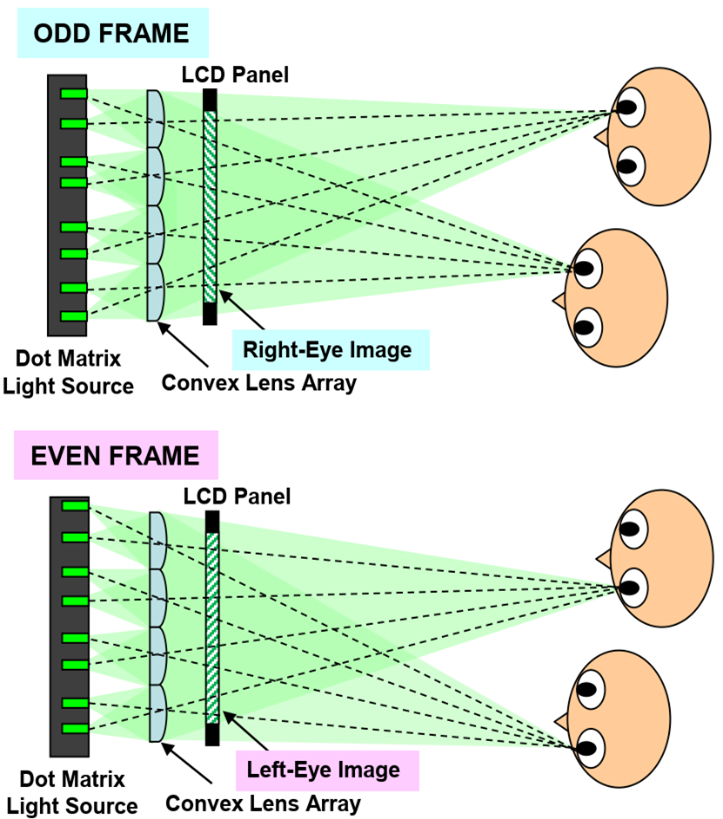Advantages
Provides high-resolution and high-brightness 3D images without the need for glasses.
Improves the convenience of stereoscopic displays by tracking the position of the user’s head using face recognition technology.
Provides 3D images from the viewpoints of multiple users.
Can be applied to a wide range of fields, including medical, industrial, and entertainment applications.
Background and Technology
Naked-eye stereoscopic display technology is a display technology that makes objects appear to float three-dimensionally without the need for special equipment such as glasses. Naked-eye stereoscopic viewing devices generally consist of a display for displaying images for the right eye and left eye captured by a stereo camera, and an optical system for properly delivering those images to the user’s right eye and left eye. There are many methods that enable naked-eye stereoscopic displays. For example, there are “parallax barrier method” and “lenticular method” as methods that create parallax by showing different images to the right eye and the left eye. They do not require special equipment such as glasses and are suitable for displaying high-resolution stereoscopic images such as landscapes. The parallax barrier method uses a grid of slits to deliver images for the right eye and for the left eye to each eyes, respectively, while the lenticular method uses a hemispherical lens to deliver images for the left and right eye. In the conventional technologies, both methods have a problem that if the user moves, the images for the right eye and the left eye are shifted and the stereoscopic image is not reconstructed, which spoils the user’s degree of freedom.
Dr. Hideki Kakeya of Tsukuba University, a leading researcher on naked-eye stereoscopic displays, solved the problem of user’s degree of freedom by introducing a head position tracking technology using face recognition. In other words, in the case of the lenticular method, the position of the image displayed by the display is moved according to the position of the user’s head, so that the images for the right and left eyes are accurately delivered to the eyes to realize stereoscopic display. In the figure below, the transmissive LDC panel displays images for the right and left eyes while switching between them at high speed, while the point light source created by the device (Dot Matrix Light Source) behind the LCD panel moves with the position of the user’s head to project images to the user’s right or left eye. This technology enables displays, whether lenticular or parallax barrier type, that provide high-quality 3D display even if the user moves. Furthermore, this technology also can generate point light sources for multiple users. The multiple light sources enable multiple users to view the stereoscopic image from their respective viewpoints. Dr. Kakeya and his colleagues have already developed a naked-eye stereoscopic display that can be used by multiple people simultaneously, and have already demonstrated its technical feasibility.
 |
Figure taken from Kakeya Lab’s doctoral thesis.
Publications
Thesis reporting the latest technology for lenticular systems.
Optics Letters Vol. 47, Issue 2, pp. 301-304 (2022)
https://doi.org/10.1364/OL.446701
Patents
Patent No. 6411025 and many other patents and applications.
Researchers
Hidenori Kakeya, Associate Professor, Faculty of Engineering, Information and Systems, University of Tsukuba
Expectations
The University of Tsukuba can provide information and know-how on stereoscopic display technology to companies working on the development of naked-eye 3D displays. For companies that are proactively developing products using their own resources, the university supports development by providing research results, technical consulting, and patent licensing.
Dr. Kakeya is also researching another naked-eye 3D display technology called integral imaging. For more information, please refer to the separate page on this technology. (https://bionauts.jp/?p=2574)
Project No: DA-04409


